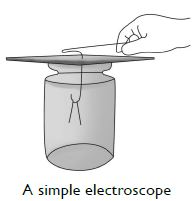Question 1:
Which of the following cannot be charged easily by friction?
- A plastic scale
- A copper rod
- An inflated balloon
- A woollen cloth
Answer:
A copper rod
Question 2:
When a glass rod is rubbed with a piece of silk cloth the rod
- and the cloth both acquire positive charge.
- becomes positively charged while the cloth has a negative charge.
- and the cloth both acquire negative charge.
- becomes negatively charged while the cloth has a positive charge.
Answer:
becomes positively charged while the cloth has a negative charge.
Question 3:
Like charges attract each other.
- TRUE
- FALSE
Answer:
FALSE
Question 4:
A charged glass rod attract a charged plastic straw.
- TRUE
- FALSE
Answer:
TRUE
Question 5:
Lightning conductor cannot protect a building from lightning.
- TRUE
- FALSE
Answer:
FALSE
Question 6:
Earthquakes can be predicted in advance.
- TRUE
- FALSE
Answer:
FALSE
Question 7:
Sometimes, a crackling sound is heard while taking off sweater during winters. Explain.
Answer:
Woollen clothes get charged when they get rubbed with the human body. When these clothes are taken off, the electric discharge takes place between the sweater and the body. This electric discharge produces crackling sound.
Question 8:
Explain why a charged body loses its charge if we touch it with our hand.
Answer:
Human body is a conductor of electricity. When we touch a charged body with our hand, the charge of the charged body passes to the Earth through our body. Thus, the charged body loses its charge.
Question 9:
Name the scale on which the destructive energy of an earthquake is measured. An earthquake measures 3 on this scale. Would it be recorded by a seismograph? Is it likely to cause much damage?
Answer:
Destructive energy of an earthquake is measured in Richter scale. Yes, an earthquake that measures 3 on the Richter scale will be recorded by a seismograph. Such an earthquake is mild and do not cause any damage to life and property.
Question 10:
Suggest three measures to protect ourselves from lightning.
Answer:
Three safety measures to protect ourselves from lightning during a thunderstorm are:
(a) Stay indoors or under a covered area
(b) Do not take a shower or bath
(c) Do not use electrical appliances or wired phones at home
Question 11:
Explain why a charged balloon is repelled by another charged balloon whereas an uncharged balloon is attracted by another charged balloon?
Answer:
Same materials get same charges on rubbing and same charges repel each other. Therefore, balloons on rubbing are similarly charged and they repel each other. The charged and the uncharged balloons do have same charges on them. Therefore, they attract each other.
Question 12:
Describe with the help of a diagram an instrument which can be used to detect a charged body.
Answer:
An electroscope can be used to detect if a body is charged or not. When a charged body touches the metal conductor, the metal strips repel each other and open wide. This proves that the body is charged.
Question 13:
List three states in India where earthquakes are more likely to strike.
Answer:
In India, the earthquake-prone areas are Kashmir, Gujarat and Rajasthan.
Question 14:
Suppose you are outside your home and an earthquake strikes. What precaution would you take to protect yourself?
Answer:
During an earthquake, if we are outside home, we should find a clear spot, away from buildings, trees and overhead power lines. If in a car or a bus, we should not come out and ask the driver to drive slowly to a clear spot.
Question 15:
The weather department has predicted that a thunderstorm is likely to occur on a certain day. Suppose you have to go out on that day. Would you carry an umbrella? Explain.
Answer:
Carrying an umbrella is not a good idea during the thunderstorm because it has metal wires and a metal rod in it which can provide an easy path for the electric discharge from the clouds. Hence, it increases the risk of electrocution in case of the lightning strikes.

